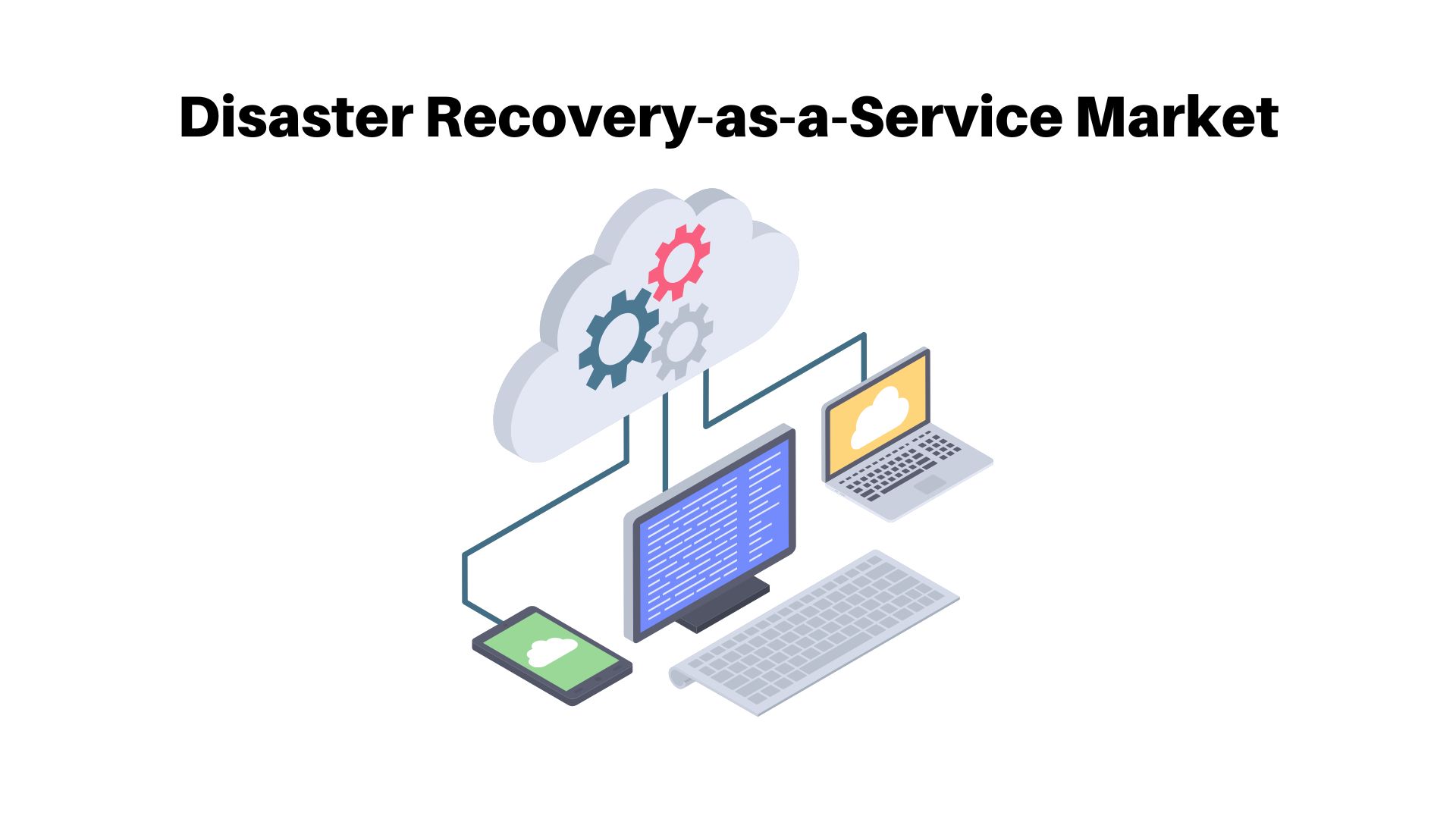Disaster Recovery-as-a-Service Market To Reach USD 75.64 Bn by 2033

Page Contents
Market Overview
Published Via 11Press: Disaster Recovery-as-a-Service (DRaaS) is a cloud-based service that allows organizations to recover their essential business systems and data in the event of disaster or disruption. Disaster Recovery-as-a-Service market providers offer businesses comprehensive disaster recovery solutions, which include planning, implementation, testing and replicating critical data to a secondary site or cloud environment managed and maintained by the DRaaS provider who also supplies all necessary infrastructure resources and support for speedy and seamless recovery after a catastrophe.
The Global Disaster Recovery-as-a-Service market represented USD 8.8 Bn in 2022 and will anticipate around USD 75.64 Bn by 2033 projected around CAGR of 21.6% amid forecast frame of 2023 to 2033.
DRaaS provides numerous advantages to organizations, such as reduced downtime, enhanced data protection and cost savings. Since it's cloud-based, organizations don't need to invest in expensive hardware or infrastructure for disaster recovery; additionally, DRaaS allows organizations the freedom to scale up or down their capabilities as needed. Businesses typically work with a provider to define their recovery objectives and requirements which then informs the design and implementation of the solution. Once implemented, businesses test it regularly to guarantee its efficacy during emergencies or disruptions.
Key Takeaways
- DRaaS (Disaster Recovery as a Service) is a cloud-based service that allows organizations to quickly and easily recover critical business systems and data during disasters or disruptions.
- The Disaster Recovery-as-a-Service Market expected to reach USD 8.8 Billion in 2022.
- Forecasted compound annual growth rates between 2023 and 2033 is 11.79%.
- By 2033, the Disaster Recovery-as-a-Service Market is projected to reach USD 75.64 Billion.
- DRaaS providers provide businesses with an all-inclusive disaster recovery solution, including planning, implementation and testing.
- DRaaS typically involves replicating essential data and systems to a secondary site or cloud environment that is managed and maintained by the DRaaS provider.
- DRaaS provides organizations with numerous advantages, such as reduced downtime, enhanced data security and cost savings.
- DRaaS is an adaptable solution, enabling organizations to expand their disaster recovery capacities as their needs evolve.
- Businesses implementing DRaaS typically collaborate with a provider to identify their recovery objectives and requirements, which will then guide the design and implementation of the solution.
- DRaaS solutions undergo regular testing to guarantee their efficacy and dependability during disasters or disruptions.

Get Disaster Recovery-as-a-Service Market Sample Report: https://marketresearch.biz/report/disaster-recovery-as-a-service-market/request-sample/
Regional Snapshot
- North America:
North America is the leading market for DRaaS, with the United States accounting for most of its growth. The region's adoption of cloud-based technologies and need for business continuity planning have driven up demand for DRaaS solutions. - Europe:
Europe is an important market for DRaaS, with countries such as Germany, France and the UK leading the adoption of this technology. Additionally, strict data protection regulations such as GDPR have further fuelled demand for DRaaS solutions within this region. - Asia-Pacific:
The Asia-Pacific region is expected to experience the highest growth in DRaaS market due to the rapid adoption of cloud technologies and increasing need for business continuity planning. Countries such as China, Japan, and India are leading this growth trend within this region. - Latin America:
The Latin American market for DRaaS is still in its early stages of development but is expected to experience substantial growth over the coming years. The regions increasing reliance on digital technologies and need for disaster recovery solutions are anticipated to propel demand within this space. - Middle East and Africa:
The Middle East and Africa region has seen an uptick in demand for DRaaS solutions due to the increasing adoption of cloud-based technologies and the necessity for business continuity planning. The market growth in this region is anticipated to remain moderate but steady over the coming years.
Drivers
- Increased Reliance on Digital Technologies: Organizations are becoming increasingly reliant on digital technologies to run their operations, leaving them more susceptible to disruption caused by cyber-attacks, natural disasters and other unanticipated events. DRaaS provides a solution that helps organizations quickly recover from these disruptions and minimize the effect on their operations.
- Cost Savings: Traditional disaster recovery solutions can be costly to implement, necessitating significant investments in hardware, software and infrastructure. On the other hand, DRaaS eliminates this need for investments, providing a more economical option for disaster recovery.
- Improved Data Security: DRaaS providers provide secure and dependable backup and recovery solutions, helping organizations safeguard their sensitive information and guarantee business continuity in case of disruption.
- Compliance Requirements: Organizations must abide by various regulations related to data protection and business continuity planning. DRaaS providers can assist organizations in meeting these compliance demands by offering comprehensive disaster recovery solutions.
- Flexibility and Scalability: DRaaS solutions offer flexibility and scalability, enabling organizations to adjust their disaster recovery capabilities as their needs change. This makes DRaaS an attractive option for organizations of all sizes and industries.
- Cloud Adoption: The increasing adoption of cloud-based technologies has contributed to the growth of DRaaS. As more organizations move their operations into the cloud, they are searching for cloud-based solutions for disaster recovery. DRaaS provides a cloud-based solution that is easily integrated with other cloud-based services and applications.
Inquire with our industry specialist: https://marketresearch.biz/report/disaster-recovery-as-a-service-market/#inquiry
Restraints
- DRaaS solutions are cloud-based, meaning they require reliable internet connections to operate efficiently. Organizations without adequate connectivity may not be able to take advantage of DRaaS solutions. Implementing and managing DRaaS solutions can be complex; organizations may need to invest in additional resources or hire outside specialists for successful implementation and management. As with any cloud-based service, there are concerns about data security and privacy – organizations must make sure their DRaaS providers offer robust security measures to safeguard data against cyber threats.
- Though DRaaS can be an economical solution for disaster recovery, it may not be suitable for all organizations. The costs associated with DRaaS can vary significantly based on the size and scope of an organization's operations. Some may even find that implementing and managing their own disaster recovery solutions is more cost-effective. Some DRaaS solutions may have limited customization options, not meeting the exact needs of some organizations. Organizations with unique disaster recovery needs may need to invest in custom solutions or continue managing their own disaster recovery initiatives. DRaaS solutions are often provided by third-party vendors, meaning organizations may become dependent on one vendor for their disaster recovery needs. This could restrict their options and flexibility if they decide to switch providers or move away from cloud-based solutions.
Opportunities
- Cloud-based technology adoption is expected to drive an uptick in demand for Disaster Recovery as a Service (DRaaS). Businesses will require reliable, effective disaster recovery solutions that seamlessly integrate with cloud infrastructures as they move more of their business operations online. Due to the cost-effective nature of traditional disaster recovery solutions, small and medium-sized businesses (SMBs) have historically been underserved in this market. DRaaS provides an economical alternative that SMBs can choose, making it increasingly attractive in this space. Furthermore, DRaaS providers continue to enhance their capabilities to offer more comprehensive disaster recovery solutions; this includes integrating artificial intelligence (AI) and machine learning (ML), automating processes for greater efficiency.
- Many companies are turning to managed service providers for IT infrastructure management and disaster recovery. This presents DRaaS providers with an opportunity to collaborate with these managed service providers to offer comprehensive disaster recovery solutions. It also gives DRaaS providers the chance to expand into new markets, especially those in emerging countries that need customized disaster recovery solutions. Moreover, they could partner with other technology providers in order to offer more comprehensive solutions; cloud providers might partner with them and offer integrated disaster recovery solutions that seamlessly integrate into cloud infrastructure.
Challenges
- DRaaS solutions can be complex and require specialized expertise to implement and manage effectively, which presents a challenge for organizations that lack the required skills or resources in-house to manage their DRaaS solutions. As with any cloud-based service, there are concerns about data security and privacy; DRaaS providers must guarantee their solutions provide robust protection measures against cyber threats. Furthermore, reliable internet connections are necessary in order for DRaaS solutions to function optimally; organizations in areas with poor internet connections may not have access to these services.
- DRaaS solutions must integrate seamlessly with existing systems and infrastructure, which can be a challenge for organizations with legacy systems or complex IT environments. Organizations must abide by various regulations related to data protection and business continuity planning in order to avoid regulatory penalties. Although DRaaS may offer cost-effective disaster recovery solutions, additional expenses such as training, consulting and maintenance may arise if your organization doesn't have sufficient budget or resources.
Market Segmentation
Segmentation by service type:
- Backup and Recovery
- Real-time Replication
- Data Protection
- Professional Services
- Training, Education, and Consulting
- Support and Maintenance
Segmentation by service provider:
- Cloud Service Providers
- Managed Service Providers
- Telecom and Communication Service Providers
Segmentation by deployment model:
- Public Cloud
- Private Cloud
- Hybrid Cloud
Segmentation by organization size:
- Large Enterprises
- Small and Medium-sized Enterprises (SMEs)
Segmentation by verticals:
- BFSI
- Consumer Goods and Retail
- Government and Public Sector
- Healthcare and Life Sciences
- Manufacturing
- Media and Entertainment
- Telecommunication and ITES
Key Players
- Amazon Web Services Inc.
- Cable & Wireless Communications Limited
- International Business Machines Corporation
- SunGard Availability Services
- TierPoint, LLC
- VMware Inc.
- Hewlett Packard Enterprise Company
- NTT Communications Corporation
- Microsoft Corporation
- Cisco Systems, Inc.
- iland Internet Solutions
- Verizon Enterprise Solutions
Report Scope
| Report Attribute | Details |
| Market size value in 2022 | USD 8.8 Bn |
| Revenue forecast by 2033 | USD 75.64 Bn |
| Growth Rate | CAGR Of 21.6% |
| Regions Covered | North America, Europe, Asia Pacific, Latin America, and Middle East & Africa, and Rest of the World |
| Historical Years | 2017-2022 |
| Base Year | 2022 |
| Estimated Year | 2023 |
| Short-Term Projection Year | 2028 |
| Long-Term Projected Year | 2033 |
Growing Demand => Request for Customization
Recent Developments
- Hybrid Disaster Recovery as a Service (DRaaS): Hybrid DRaaS solutions have become increasingly popular in recent years, offering the benefits of both on-premises and cloud disaster recovery. They provide high levels of flexibility and control, enabling organizations to store critical data locally while taking advantage of the scalability and cost efficiency of the cloud for disaster recovery.
- AI and Automation: Disaster recovery as a service (DRaaS) providers are increasingly utilizing artificial intelligence (AI) and automation to simplify disaster recovery procedures and minimize downtime. These technologies can automatically identify and prioritize critical applications, reduce manual intervention, and provide real-time updates on recovery progress.
- Multi-cloud DRaaS: As organizations adopt multi-cloud strategies, DRaaS providers are offering solutions that protect data across different cloud environments. These solutions offer great flexibility and can be tailored to suit the specific requirements of each organization.
- Increased Focus on Security: Security remains a top concern for organizations considering DRaaS solutions. In response, DRaaS providers are offering more robust security measures like encryption, multi-factor authentication and advanced threat detection.
- Emergence of Disaster Recovery Marketplaces: Disaster recovery marketplaces are emerging as a means for organizations to locate and compare DRaaS solutions from multiple providers. These marketplaces provide organizations with a centralized platform to evaluate different solutions and select one that best meets their requirements.
- Partnerships and Collaborations: DRaaS providers are joining forces with other technology providers, such as cloud providers and managed service providers, to offer more comprehensive disaster recovery solutions. Through these partnerships, customers gain access to an integrated end-to-end solution that addresses all aspects of disaster recovery.
Key Questions
1. What is DRaaS?
DRaaS stands for Disaster Recovery-as-a-Service, a cloud-based solution that offers organizations backup and recovery options in case of disaster or disruption.
2. How Does DRaaS Work?
DRaaS functions by replicating an organization's critical data and applications into a cloud-based environment. In case of disaster or disruption, organizations can quickly failover to the DRaaS environment for minimal downtime and data loss.
3. What are the Advantages of DRaaS?
DRaaS provides faster recovery times, improved reliability, scalability, cost-efficiency and flexibility.
4. What are the challenges of DRaaS?
Among them are complexity, data security concerns, dependencies on internet connectivity, integration with existing systems, compliance requirements and cost.
5. What are some recent developments in DRaaS?
Recent advances include hybrid DRaaS solutions, AI/automation, multi-cloud DRaaS, increased security focus, disaster recovery marketplace emergence, partnerships/collaborations etc.,
6. How should organizations select a DRaaS provider?
Organizations should take into account factors like pricing, reliability, scalability, security, compliance, support and integration when selecting a provider. Furthermore it's essential to assess their experience and reputation within the industry.
Contact us
Contact Person: Mr. Lawrence John
Marketresearch.Biz (Powered By Prudour Pvt. Ltd.)
Tel: +1 (347) 796-4335
Send Email: [email protected]
The team behind market.us, marketresearch.biz, market.biz and more. Our purpose is to keep our customers ahead of the game with regard to the markets. They may fluctuate up or down, but we will help you to stay ahead of the curve in these market fluctuations. Our consistent growth and ability to deliver in-depth analyses and market insight has engaged genuine market players. They have faith in us to offer the data and information they require to make balanced and decisive marketing decisions.



